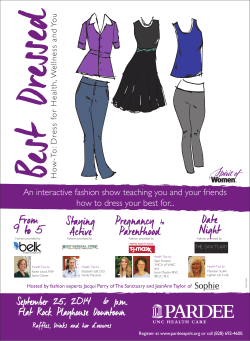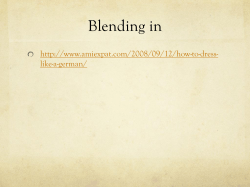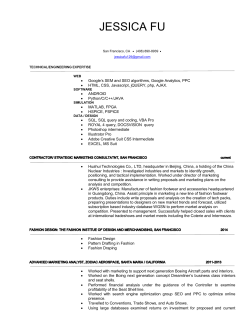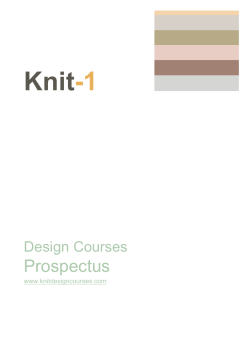
Understanding Fashion, Grade 11âCollege Preparation (HNC3C)
CURRICULUM CORRELATION Understanding Fashion, Grade 11—College Preparation (HNC3C) and The World of Fashion The World of Fashion Student Resource and Teacher Resource fully address the curriculum expectations of the Family Studies course Understanding Fashion, Grade 11—College Preparation (HNC3C), as prescribed in the 2013 Ontario Curriculum for Social Sciences and Humanities. PAGE NUMBERS EXPECTATION Student Resource Teacher Resource A. Research and Inquiry Skills A1. Exploring: explore topics related to fashion, and formulate questions to guide their research. A1.1. Explore a variety of topics related to fashion (e.g., cultural influences on dress, fashion cycles, fashion marketing, media and advertising, body image, fibre and fabric characteristics, elements and principles of design) to identify topics for research and inquiry 19, 26, 39, 48, 52, 70, 107, 111–112, 129, 173, 206, 315, 319, 322, 334 40, 47, 57, 59, 70, 95, 97, 99 – 100, 112, 148, 175, 246, 249, 261 A1.2. Identify key concepts (e.g., through discussion, brainstorming, use of visual organizers) related to their chosen topic 107, 111, 328 95, 97, 99–100, 252 A1.3. Formulate effective questions to guide their research and inquiry 83, 87, 107, 123, 129, 206 80, 83, 95, 99–100, 112, 175 Teacher prompt: “If you wanted to research fashion marketing strategies, which types of goods would you want to consider (e.g., sportswear, children’s wear, exclusive clothing lines)? Why might a comparative approach be useful?” A2. Investigating: create research plans, and locate and select information relevant to their chosen topics, using appropriate social science research and inquiry methods. A2.1. Create appropriate research plans to investigate their selected topics (e.g., outline purpose and method; identify sources of information; ensuring that their plans follow guidelines for ethical research 19, 67, 84, 99, 120, 136, 143, 151, 156, 202, 212, 315 47, 66, 80, 92, 112, 115, 123, 129, 131, 169, 176, 177, 246, 268 A2.2. Locate and select information relevant to their investigations from a variety of primary sources (e.g., interviews, observations, surveys, questionnaires, photographs in magazines, billboards) and/or secondary sources (e.g., textbooks, book reviews) 35, 59, 67, 70, 84, 120, 136, 143, 151, 156, 167–168, 178, 319, 340, 346 56, 65–66, 70, 80, 112, 115, 123, 129, 131, 146, 150, 177, 249, 261, 265, 268 A2.3. Based on preliminary research, for each investigation formulate a hypothesis, thesis statement, or research question, and use it to focus their research 59, 100, 118, 136, 202, 322, 326 65, 92, 108, 115, 169, 177, 249, 252 A3. Processing Information: assess, record, analyse, and synthesize information gathered through research and inquiry. A3.1. Assess various aspects of information gathered from primary and secondary sources (e.g., accuracy, relevance, reliability, inherent values and bias, voice) 1 52, 67, 70, 118, 151, 167–168, 209, 340 59, 66, 70, 108, 129, 146, 172, 177, 261 Pacific Educational Press Curriculum Correlation—Understanding Fashion (HNC3C) PAGE NUMBERS EXPECTATION Student Resource Teacher Resource A3.2. Record and organize information and key ideas using a variety of formats (e.g., notes, graphic organizers, summaries, audio/digital records) 28, 35, 167–168 47, 56, 172, 177 A3.3. Analyse and interpret research information (e.g., compare observations with predictions; determine whether common themes arise in research from/on different periods) 28, 35, 209 47, 56, 172, 177 A3.4. Demonstrate academic honesty by documenting the sources of all information generated through research 63, 168, 202 66, 146, 169, 177 A3.5. Synthesize findings and formulate conclusions (e.g., determine whether their results support or contradict their hypothesis; weigh and connect information to determine the answer to their research question) 52, 118, 120 59, 108, 112, 177 A4. Communicating and Reflecting: communicate the results of their research and inquiry clearly and effectively, and reflect on and evaluate their research, inquiry, and communication skills. A4.1. Use an appropriate format (e.g., oral presentation, written research report, poster, multimedia presentation, web page) to communicate the results of their research and inquiry effectively for a specific purpose and audience 39, 43, 63, 92, 99, 146, 199, 346, 348 57, 66, 84, 92, 127, 175, 265, 266, 282–283 A4.2. Use terms relating to fashion correctly (e.g., fashion cycles, marketing, positional goods, pattern, dart, seam, gather, ease, line, colour, shape, texture) 92, 107, 348 84, 95, 266, 282–283 A4.3. Clearly communicate the results of their inquiries (e.g., write clearly, organize ideas logically, use language conventions properly), and follow APA conventions for acknowledging sources (e.g., generate a reference list in APA style, use in-text author-date citations) 63, 92, 107, 168, 202 66, 84, 95, 146, 169, 268, 282–283 A4.4. Demonstrate an understanding of the general research process by reflecting on and evaluating their own research, inquiry, and communication skills 63, 100, 151, 346 66, 92, 129, 265, 282–283 Teacher prompts: “How might your results have differed it you had conducted a survey rather than made your own observations?” “What steps might you take to enhance your research/inquiry skills?” B. Influences on Fashion B1. Cultural Influences: demonstrate an understanding of how culture influences fashion. B1.1. Identify and describe garments and styles of personal adornment typical of various cultures (e.g., sari, turban, parka, kimono, ribbon shirt, dance shawl, kilt, hijab, burka, yarmulke, tattoos, scarification, piercings) Teacher prompts: “What are the different styles of wearing hijab?” “What are some different methods of scarification?” “In what ways is the Muslim kufi similar to the Jewish yarmulke?” 2 17–18, 20–25, 27, 29, 30–51, 53 38–48, 55–59 Pacific Educational Press Curriculum Correlation—Understanding Fashion (HNC3C) PAGE NUMBERS EXPECTATION B1.2. Explain how various garments and styles of personal adornment express a person’s cultural identity and heritage (e.g., kilts identify Scottish clans; items such as a hijab, burka, or kippah identify the religion of the wearer) Student Resource Teacher Resource 17–18, 20–25, 27, 29, 30–51, 53 38–48, 55–59 30–51, 53 55–59 Teacher prompts: “How is clothing used to express different aspects of people’s identity?” “Why does a woman wear a hijab? Why does a man wear a yarmulke? Why is it significant that some women now wear yarmulkes?” “What is the significance of differences in styles of dress among groups who live in or come from India?” “What sorts of dress are worn for cultural celebrations in your community? Why?” B1.3. Describe ways in which current fashion trends reflect aspects of garments and adornment associated with various cultures (e.g., the Mandarin collar, moccasins, nose piercings, the keffiyeh, dashikis) Teacher prompt: “What are some examples of dress from specific cultures that have been adopted by the mainstream fashion industry? What are some of the effects when the Western fashion industry adopts or appropriates such items?” B2. Media Influences: demonstrate an understanding of how media influence fashion. B2.1. Explain the ways in which different media (e.g., music videos, television shows, movies, the Internet, fashion magazines, billboards, window displays) influence the fashion industry and individual fashion choices 54–66, 68–69, 71 64–65, 67–70 54–66, 68–69, 71 64–65, 67–70 Teacher prompts: “To what extent does coverage of gala events such as award shows and celebrity weddings influence fashion trends?” “In what ways do popular fashion magazines, music videos, and TV programs affect your clothing choices?” B2.2. Analyse how the media influence social norms with respect to fashion, and describe the effect these norms can have (e.g., how young pop stars wearing revealing clothing in music videos contributes to the hypersexualization of children) Teacher prompts: “What messages do the mainstream media convey with regard to body size and fashion? With regard to gender roles and fashion? What impact might such messages have on adolescent girls and boys?” “How have male and female models seen in the media changed over the past fifty years? Considering norms, values, and trends today, what do you think models might look like twenty years from now?” 3 Pacific Educational Press Curriculum Correlation—Understanding Fashion (HNC3C) PAGE NUMBERS EXPECTATION Student Resource Teacher Resource B3. Fashion Cycles and Trends: demonstrate an understanding of fashion cycles and trends and of factors that influence them. B3.1. Identify and describe the stages of a fashion cycle (i.e., introduction, growth, maturity, decline, and obsolescence) 310–329 244–253, 267–268 310–329 244–253, 267–268 310–329 244–253, 267–268 Teacher prompts: “Why are end-of-season sales common in clothing stores?” “How long is the typical fashion cycle for clothing items? Why might fashion cycles for teen and young adult clothing be shorter than those for clothing designed for other age groups?” B3.2. Explain theories that have been developed to account for the origin and adoption of fashion trends (e.g., trickle up, trickle down, trickle across), and describe the use of these theories in the fashion business Teacher prompt: “How are fashion theories used when predicting future trends? How do these theories influence fashion business decisions?” B3.3. Analyse how social factors, including current events, influence fashion trends and cycles (e.g., factors such as historical events, technological advances, economic factors, geographical factors, environmental issues) Teacher prompts: “In what ways have sports influenced fashion trends?” “How has concern for the environment affected current fashion trends?” “How do economic recessions or depressions affect attitudes towards luxury fashion items?” C. Marketing, Environmental Responsibility, and Consumer Behaviour C1. Consumer Behaviour and Fashion Marketing: demonstrate an understanding of consumer behaviour and marketing strategies, including specific social marketing promotions, associated with the fashion industry. C1.1. Explain the elements of marketing in the fashion industry (i.e., product, placement, price, promotion) 330–334 258–261, 262, 267–268 333–343 260–262, 267–268 Teacher prompt: “What are some of the factors that marketers consider when deciding on the price of a fashion item? Why does a low price not necessarily lead to higher sales?” C1.2. Explain strategies that fashion marketers use to create a sense of need among consumers, and describe the effects of these strategies (e.g., manufacturing demand for clothing that has “cool” labels/logos; convincing consumers to replace garments that are out of style rather than worn out; creating a market for positional goods, whose value is based on exclusivity, and knock-offs of these items) Teacher prompts: “What type of running shoes do you wear? Why?” “What is meant by the term positional goods in the context of fashion? What impact do such goods have?” “When you view fashion advertisements, how can you determine which markets are being targeted and which groups are being excluded?” 4 Pacific Educational Press Curriculum Correlation—Understanding Fashion (HNC3C) PAGE NUMBERS EXPECTATION C1.3. Explain how marketing in the fashion industry can affect consumer behaviour (e.g., impulse buying, accessorizing, combination buying, buying items endorsed by celebrities) Student Resource Teacher Resource 333–343 260–262 344–349 263–266 342–343 261 Teacher prompts: “Why do store window displays feature fully accessorized mannequins?” “Have you ever bought more items than you intended or needed because a store was having a sale? Have you ever made an impulse purchase of an item displayed near the cash register? What does this behaviour indicate about the effectiveness of these marketing strategies?” C1.4. Describe strategies that consumers can use to make informed and responsible fashion purchases (e.g., checking textile labels, comparison shopping, checking warranties/guarantees, wardrobe assessment, checking return policies, investigating the working conditions under which the garment was produced and sold) Teacher prompts: “What types of fashion items are covered by warranties/guarantees? Why is it important to be aware of such guarantees when shopping for such items?” “What constitutes a socially responsible fashion choice?” “To what extent do fair-trade products guarantee ethical working conditions?” C1.5. Analyse fashion promotions and products that raise awareness of social issues (e.g., charity fashion shows such as Fashion Cares, ribbons symbolizing issues such as breast cancer and HIV/AIDS awareness, T-shirts with messages, reusable shopping bags) Teacher prompts: “What are some fashion products that promote awareness of environmental issues? How effective do you think they are?” “How and why might some fashion retail chains be motivated to develop social marketing promotions?” C2. Fibres, Fabrics, and the Environment: demonstrate an understanding of fibres, fabrics, and finishes, and of the environmental impact associated with their production and use. C2.1. Identify the advantages and disadvantages of common natural and synthetic fibres (e.g., cotton is lightweight, breathable, and easy to find, but it can shrink when washed and is easily creased; silk is hypoallergenic, breathable, and strong, but it is expensive and the fibres are weakened by perspiration; spandex increases the stretch of a garment, but it is not breathable; polyester is relatively inexpensive and holds its shape and colour, but it is not absorbent, does not breathe, and can cling as a result of static electricity) Teacher prompts: “What are some advantages and disadvantages of new fibres such as bamboo, soy, and hemp?” “Why is spandex particularly suitable for use in swimwear?” “When might you wear a garment made of Gore-tex? When would you not want to wear such a garment? Why?” “What are the advantages and disadvantages of down insulation?” 5 158–167, 179 144–146, 150 Pacific Educational Press Curriculum Correlation—Understanding Fashion (HNC3C) PAGE NUMBERS EXPECTATION Student Resource Teacher Resource 169–173, 179 147–148, 150 174–177, 179 149–150 196–198, 200–205, 207–208, 210–211, 213 167–176 C2.5. Describe strategies to reduce the environmental impact of the production of various fibres, fabrics, and finishes (e.g., purchasing garments made from organic cotton or hemp, using plant-based dyes, buying second-hand clothes, limiting the use of stain-resistant fabric) 196–198, 200–205, 207–208, 210–211, 213 167–176 C2.6. Apply their knowledge of the basic characteristics of various fibres and fabrics and their environmental impact when choosing appropriate fabrics for various fashion products 196–198, 200–205, 207–208, 210–211, 213 167–176 C2.2. Describe characteristics of different types of woven fabrics (e.g., canvas, chino, damask, linen, percale), knit fabrics (e.g., jersey, tricot, velour, boiled wool), and non-woven fabrics (e.g., leather, fur, felt) used in various fashion products Teacher prompts: “What are the main differences between canvas and percale?” “In what ways does jersey differ from velour?” C2.3. Describe characteristics of various types of dyes (e.g., natural, acid, reactive, solvent) and fabric finishes (e.g., waterproof, flame-retardant, wrinkle-resistant, stain-resistant finishes), and describe the effects they have on fabrics Teacher prompts: “Why might some natural dyes have a more negative impact on the environment than some synthetic dyes?” “How do various fabric finishes affect the lifespan of a garment?” “Which fabric finishes would be desirable for a raincoat? Why?” “Which finishes enhance the appearance of a garment?” C2.4. Describe the environmental impact of the production, use, and care of various fibres and fabrics (e.g., the impact of farming cotton, hemp, bamboo, sheep, silkworms; of the production process for various synthetic fabrics and dyes; of dry cleaning) Teacher prompts: “Which is more damaging to the environment – washing garments at home or having them dry cleaned? Why?” “What is the environmental impact of the chemicals used in stain-resistant finishes?” “What is the environmental impact of using dyes in the production of fibres?” Teacher prompts: “What is the purpose of your fashion product? Does that purpose narrow the range of fabrics that you might consider? Why or why not?” “How will the fabric that you have chosen complement the design of this product?” 6 Pacific Educational Press Curriculum Correlation—Understanding Fashion (HNC3C) PAGE NUMBERS EXPECTATION Student Resource Teacher Resource D. Design and Fashion Construction Skills D1. Elements and Principles of Design: demonstrate an understanding of the elements and principles of design, and of how they can be used to different effect in the creation of fashion products. D1.1. Identify and describe the elements and principles of design as they apply to fashion products (e.g., line, colour, shape, texture, balance, proportion, rhythm, emphasis, harmony) 72–93, 94–99, 100–113 78–84, 90–98 72–93, 94–99, 100–113 78–84, 90–98 72–93, 94–99, 100–113 78–84, 90–98 Teacher prompt: “What are some ways of using colour or texture to show contrast in a garment?” D1.2. Analyse the impact that apparel and/or accessories reflecting various elements and principles of design can have on a person’s appearance and the impression he or she creates Teacher prompts: “Why do horizontal lines on some garments make a person appear wider?” “Why does dark clothing make a person appear smaller?” “What is the effect of clothes or accessories in bright colours?” D1.3. Apply the elements and principles of design when creating fashion-related products (e.g., when creating fashion illustrations, fashion sketches, apparel for paper dolls of different body shapes; when designing a garment; when engaged in a sewing project) Teacher prompts: “Are you going to run the lines in your fabric horizontally or vertically in the garment you are creating? Why? What effect will that produce? How would the effect be different if the lines ran the other way?” “How can a fashion illustration that shows formal balance be modified to show informal balance in a similar garment?” D2. Tools and Technologies: describe a variety of tools and technologies associated with the creation of fashion products, and use tools and technologies safely and correctly when creating such products. D2.1. Identify various tools and technologies used in the creation of fashion products, and describe their function (e.g., measuring tape, seam ripper, scissors, pinking shears, iron, pressing ham, sewing machine, serger, loom, knitting needles, crochet hook) 119, 121–128, 130– 135, 137, 139–146, 151–155 110–112, 114–115, 122–127, 130–131 117, 119, 121–128, 130–135, 137, 146–150 108–109, 111–112, 114–115, 125–129, 132–134 Teacher prompt: “What cutting tools are necessary to make clothing? What are the differences in the functions of various cutting tools?” D2.2. Demonstrate the safe use of tools and technologies when creating fashion products (e.g., keep pins in a pin cushion, store the iron on its heel when not in use, promptly replace blunt or bent needles in sewing machines or sergers) Teacher prompts: “Why is it important to replace a bent or dull needle on a sewing machine?” “When using a sewing machine, why is it important to wear safety glasses or tie back long hair?” 7 Pacific Educational Press Curriculum Correlation—Understanding Fashion (HNC3C) PAGE NUMBERS EXPECTATION D2.3. Use tools and technologies correctly when creating fashion products (e.g., tools and technologies associated with cutting, pressing, pinning, sewing, knitting, crocheting, felting, embroidering, dyeing) Student Resource Teacher Resource 119, 121–128, 130– 135, 137, 139–155 111–112, 114–115, 122–134 Teacher prompt: “How would you use a measuring tape to place a pattern piece correctly on fabric?” D3. Procedures, Skills, and Techniques: demonstrate the ability to use appropriate procedures, skills, and techniques when creating fashion products. D3.1. Demonstrate the ability to follow preconstruction procedures (e.g., measuring; interpreting patterns, including their abbreviations, and laying out patterns; selecting and preparing fabrics; fitting and altering patterns; understanding knitting, crocheting, or jewellery-making instructions) when creating fashion products 140–146 122–126 122, 147–150 128–129 147–150 129, 132–134 Teacher prompt: “How would you use numeracy skills to measure a grainline or determine the number of metres of fabric required?” D3.2. Identify and describe basic skills and construction techniques used in the creation of fashion products (e.g., finishing seams, sewing darts, gathering and easing fabric, making buttonholes, sewing in zippers, hemming, reducing bulk, using stabilizers and interfacing) Teacher prompt: “What are the main differences between sewing in a conventional zipper and an invisible zipper?” D3.3. Demonstrate the ability to apply basic skills and construction techniques when creating fashion products (e.g., finishing seams, sewing in zippers, hemming, using fasteners) Teacher prompts: “How can you determine how much seam allowance you will need?” “What techniques can you use to ensure a straight hem in a garment you are sewing?” 8
© Copyright 2025









